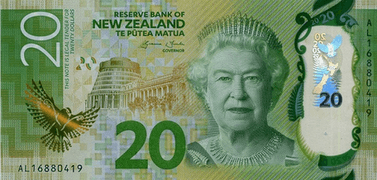New Zealand twenty-dollar note
The New Zealand twenty-dollar note ($20) is the current middle denomination banknote of the New Zealand dollar.
| (New Zealand) | |
|---|---|
| Value | 20 New Zealand Dollar |
| Width | 145 mm |
| Height | 70 mm |
| Security features | Window, Shadow image |
| Material used | Polymer |
| Years of printing | 1999-present[1] |
| Obverse | |
 | |
| Design | Elizabeth II |
| Design date | May, 2016[2] |
| Reverse | |
| Design | kārearea |
| Design date | May, 2016 |
The $20 note was introduced on 10 July 1967, replacing the New Zealand ten-pound note.
Design
First issue (1967 to 1981)
The first $20 notes featured Her Majesty Queen Elizabeth II on the obverse, with a window watermark panel showing a portrait of Captain James Cook. The obverse featured a kereru (Hemiphaga novaeseelandiae) and a miro (Prumnopitys ferruginea).
Second issue (1982 to 1990)
This issue's design was very similar to the first issue, with the most obvious difference being the updated portrait of Queen Elizabeth II. There is also some new color changes.
Third issue (1990 to 1999)
In 1990, all of New Zealand's notes were redesigned. The new $20 note featured Queen Elizabeth II and the New Zealand Parliament Buildings on the obverse, while the reverse featured a New Zealand Alpine scene, containing a kārearea (Falco novaeseelandiae), Marlborough rock daisy (Pachystegia insignis), Flowering red tussock (Chionchloa rubra) and Mount Tapuaenuku. This note is different from the fourth series because it was issued in cotton not polymer.
Fourth issue (1999 to 2016)
In 1999, the material used to make twenty dollar notes was changed to polymer. The basic design of the note remained unchanged, although new anti-counterfeiting measures such as transparent sections of the note were added, and the metallic stripe removed. The 20 has the New Zealand Parliament Buildings on it, which is to the left of Elizabeth II, the portrait was taken in 1986. On the back is the kārearea. The scene in the background is Mount Tapuaenuku, the highest peak on the South Island's Inland Kaikoura range, standing at 2,885 Meters (9,465 ft) in height.[3]
Fifth issue (2016 to present)
The note was made brighter.[4] The $20 note is by far the most commonly used denomination in New Zealand. It is the main note dispensed from Automatic Teller Machines and probably 90% of all notes from ATMs are $20s. Only a few ATMs dispense $10 notes (and some now, $50s). The note is accepted everywhere and seldom attracts the same suspicion from shop keepers that the $50 and $100 note does. Gaming machines also have the $20 as their top accepted note and many people will often avoid ATMs that insist on dispensing $50s as they find the larger note inconvenient. The $20 is also a convenient note as a gift to children and for small purchases like fast food and public transport journeys.
The $20 note is the most common note in circulation. As of March 2019, there were an estimated 59.7 million $20 notes were in circulation worth, representing 31.6% of all dollar notes (29.4% including the now-demonetised $1 and $2 notes).[5]
Security features
The note has a clear window of a fern on the left and an oval-shaped window on the right, with the denomination burned on to it. There is a fern printed on the both sides; when held up to the light the fern will be complete and match up perfectly. Above the oval window, there is a watermark of Elizabeth II when it's held up to the light. When put under UV Light a yellow patch will appear with the denomination on it.[6]
References
- http://www.rbnz.govt.nz/notes_and_coins/
- Reserve Bank of New Zealand
- "Archived copy" (PDF). Archived from the original (PDF) on 2013-07-12. Retrieved 2012-12-20.CS1 maint: archived copy as title (link)
- https://www.rbnz.govt.nz/notes-and-coins/notes/banknotes-in-circulation
- "Bank notes in the hands of the public - F3 - Reserve Bank of New Zealand". www.rbnz.govt.nz. Retrieved 2019-10-03.
- http://www.rbnz.govt.nz/notes_and_coins/notes/polymer.pdf